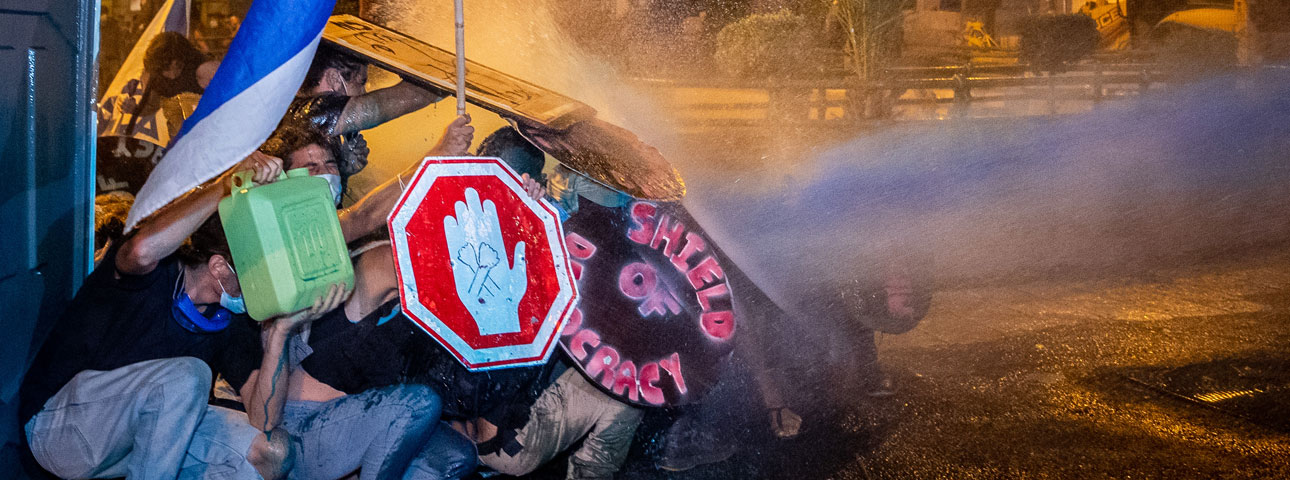Two Cities Two Protests
The Jerusalem's police force's aggressive stance, with its water cannons at the ready, play a key role in amplifying public awareness of the recent protests in the capital.

Flash 90
What’s the difference between a park for bridal photoshoots and enjoying a night out at a protest? And why couldn’t the protest in the capital have asked for a better location?
Just like pornography, protest is a matter of geography. The site at which it takes place largely determines its character, its public image, the authorities’ reaction, and the counter-protest, as well as the media coverage, which is of critical importance to its success. There are places that are "meant to be" protest sites – whether it is Tahrir Square or Rabin Square – where even before a single sign is hoisted, the protest will be the right thing in the right place. In other sites, even a huge crowd will not be enough to gain momentum.
The site chosen for the protest should match its size (a large square with people few and far between signals failure) and preferably – it should also have a history of protest. It must be in the heart of a city, accessible, and friendly to media coverage. Authorities, however, will always prefer to push the protest to the outskirts of the city, to sites that are not identified with civic action, and that are inaccessible and inconvenient for media reporting.
Back to the demonstration on Saturday night: The site for the Tel Aviv protest on the economic situation--the Charles Clore Park – last Saturday night could have made for a more effective demonstration, had it been held in Habima Square, or even better-- in Rabin Square. The Clore Park is a popular site for bridal photoshoots, for a pleasant evening out, or for sports events, but is too dimly lit for the protesters to make eye contact and enjoy the feeling of “esprit de corps”, that is essential for harnessing energies and for the fighting spirit generated by the size and visibility of the gathering. Moreover, the organizers' stated desire to uphold health regulations and maintain physical distance between the protesters –so as to be awarded a “seal of kashrut” affirming that they are not anarchists, but rather – law-abiding citizens in distress – has made it difficult to generate the excitement and militancy that are essential ingredients for effective protest. Furthermore, the messages from the stage did not shut the door to reconciliation with the heads of government, provided they would open their ears and extend financial aid to those who were dealt a blow by the corona virus crisis.
At the same time, on Balfour Street, in front of the Prime Minister’s residence in Jerusalem, the tension was in the air even before the protest began. The security forces, who—in Tel Aviv—were leaning on their cars, smoking and chatting leisurely on the beach throughout the demonstration, stood in a tight ring around Paris Square, alert and ready for confrontation; some even armed with long-barreled weapons not to be seen in a civilian event. Within a short time, the site was brimming with protesters, and the overcrowding was clearly exacerbated by the concrete checkpoints set up by the police. The sight of the APCs (Armored Personnel Carriers) and water cannons, created an energetic protest space in the right place – in the heart of the capital, adjacent to symbols of government (the Prime Minister’s residence). It is the perfect backdrop for iconic photographs like the one from last week of the young demonstrator tenaciously hanging on to the Israeli flag under the water hoses of the police.
While in Tel Aviv the protesters stood one-by-one (keeping a distance of two meters from each other – remember?). In Jerusalem it was clear that several tightly knit groups were present – veterans of the Petah Tikva protest, members of the “Black Flag”, movement, members of “No Way”, people with pink bandanas, and others. But all of them shared a common message – crystal-clear and uncompromising – Bibi go home!! They were saying – there is no pardon and no forgiveness and there no going back. Unlike in Tel Aviv, the police here are not our “brothers”. Given the tight space, the explosive energies, and the menacing scenery, both sides – the protesters and the security forces – came prepared for an evening that would end in a brawl, a familiar and integral part of the "protest drama."
Two cities; two protests; and protests on bridges across the country. Now the question is whether a critical mass of protesters will be formed in the coming weeks, given that both in Tel Aviv and in Jerusalem, the numbers were not large enough to justify the title—a "State in Protest". Someone needs to send out a message to connect all these “shows” so that the whole is greater than the sum of its parts, and so that with the end of the summer vacation and the coming of the holidays, and perhaps a moment after the savior vaccine is found to end the pandemic this will not turn out to be yet another demonstration leaving behind only remnants of signs, pieces of pink and black cloth, and once again – a heartbroken public.
The article was published in the Times of Israel.
